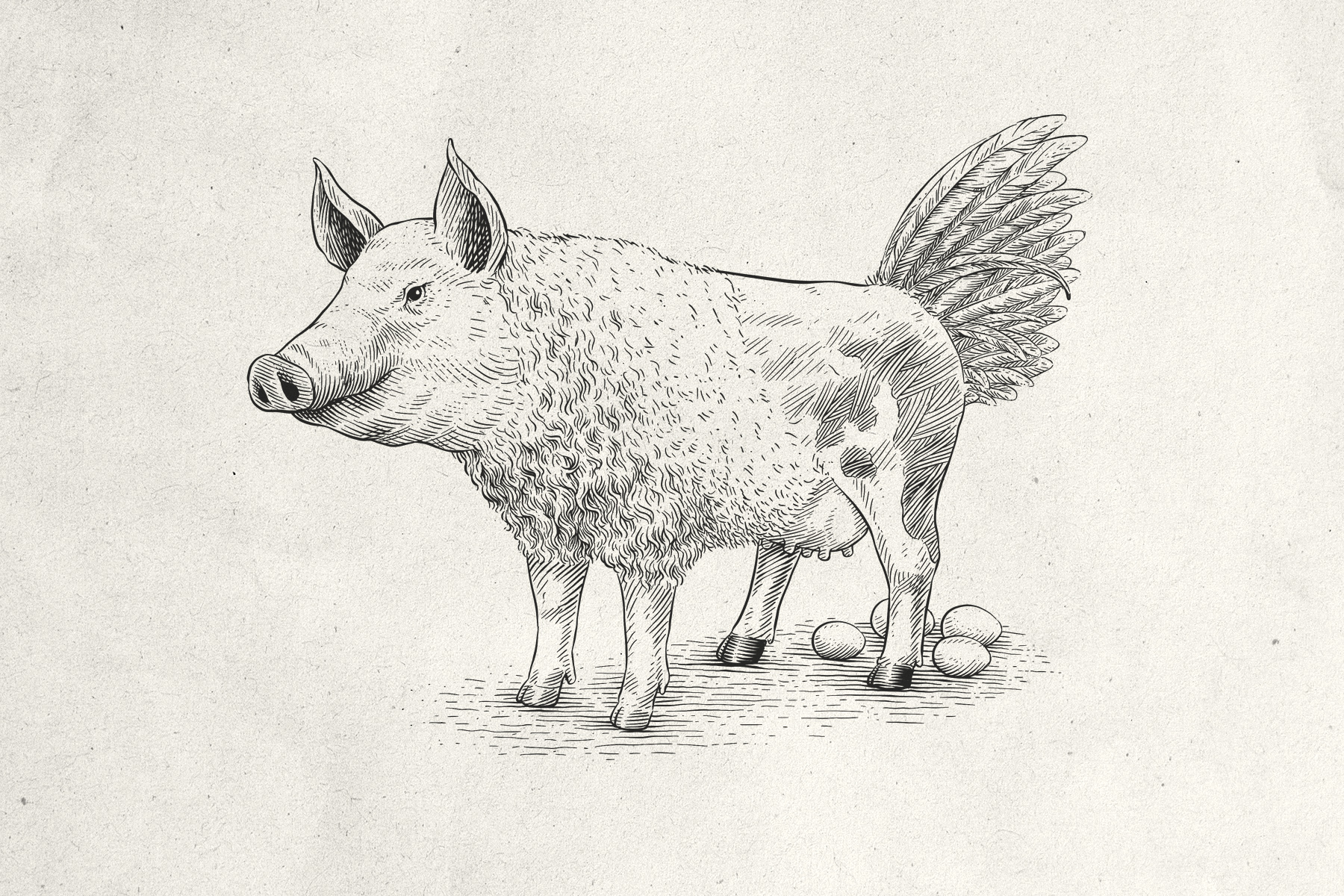
What kind of Thing?
Notes on Branding
The other day at the FH, I looked at my watch and realise that, afraid of being late, I was way too early – it happens every single time. So I sit down at the lecturer’s desk and curse nervously to myself. A student enters the room and makes a startled face when he sees me. His forward movement is delayed for the blink of an eye – just like that feint at the penalty kick.
He notices: He is the first. And his lecturer is already here. (Why is he, anyways?) How unpleasant. Running away is out of the question, that would look stupid.
So the two of us are standing in a room that suddenly feels bigger than it is. Out of politeness, we pretend to be very interested in one other. I ask him how his studies are going – my standard question that I always ask the very first student I meet (sorry!). I don’t remember his answer. But the rest of the conversation is stuck:
He: "And what do you do?" Me: "Branding."
He [completely confused]: "What kind of thing?"
Priceless.
But admittedly, the question hits the nail on the head. Branding is a very vaguely defined subject. Marketing, corporate identity, visual identity or aforementioned branding – these terms are often used synonymously. And not just by laypersons, but by many people who ought to know better. But in truth, they all describe different, albeit closely related, concepts.
Here are the most frequently asked questions from my students – and an attempt to answer them from my point of view.
What is a brand?
Your brand is what others think about you. This can be confusing at first, so here are two examples: The value of the brand Apple is based on the excitement it creates in the minds of its customers. The value of the brand Intel is the result of the expertise we attribute to Intel and its products.
Images create trust because we always know where we stand. For us consumers, this is reason enough to dig deeper into our pockets.
A brand is the result of the interplay between communication and perception. This also means that if a company preaches quality but does not deliver, its image will suffer – and so will the value of its brand.
Thus, a brand just happens. As Paul Watzlawick writes, we cannot not communicate. And according to the principle of cause and effect, every form of communication has its impact.
What is branding?
The term branding refers to methods and models for becoming aware of these mechanisms and for using messages and channels to build, reinforce or change a very specific image. Branding is therefore strategically aimed at establishing a very specific brand.
What influence does identity have on a brand?
We cannot escape our identity, no matter how hard we try. And our identity is exposed: through our behaviour, the way we communicate, the style of our clothes, even the choice of our friends. Much of this is done subconsciously, some of it unconsciously. And it’s no different with companies:
A corporate identity grows quite naturally; founders gather people around them who share their goals, ideas and views, especially at the beginning. Eventually, the values of individuals become the beliefs of a collective.
This common attitude is reflected in the company’s culture (corporate culture), behaviour (corporate behaviour), activity (services or products), but also in its communication (corporate communication) and appearance (corporate design).

The corporate identity model according to Metadesign. Left: the company. Right: the image / the brand.
Credit: Florian Hämmerle
Is branding the same as corporate identity?
Many agencies use the two terms synonymously. However, the term corporate identity is somewhat misleading because identity is not a service provided by agencies. It exists in advance and has grown naturally. Agencies do not define identity, but develop a language to make it visible and perceptible as a personality, both internally and externally.
To do this, designers and strategists need to analyse the existing reality, understand a client's identity and identify what is unique about it. When this is accomplished, the design and language express what is really there. The system is right in itself.
What is the role of the logo in branding?
Like all other elements in branding, the logo fulfils a very specific role – no more, no less. In this particular case: to mark a message with a very specific sender. The logo acts like a signature.
A company’s messages and statements, its culture, the behaviour of its employees, but also the environment in which I encounter a company and its people – all these things create moments that noticeably influence our attitude towards its services or products.
The logo evokes these associations – both positive and negative. So if we associate good moments with a company, the logo will evoke good emotions. The same goes for the bad ones.
Therefore, designers do not create “emotional” logos, as is often requested in client briefings. Instead, the emotions we associate with a logo emerge from our encounters with a product or company.
This is good news for designers, as it allows them to focus on what makes a good logo: aesthetics, legibility, replicability and recognisability.
What makes good brand communication?
Good communication starts with asking the right questions – and asking them in the right way. “What does the target audience want to hear?” becomes “What do I have to offer? And which audience will respond?” Good brand communication expresses what is really there and is heard by people who want to hear it.
This has several advantages: the truth is easier to remember. The company has to bend less. And there is no contradiction between the product and the communication.
Resonance ensures that the chemistry is right. Service providers in particular attract customers who are easier and more enjoyable to work with.
But what if the target audience doesn’t want to hear the truth?
Branding is like a frame that needs to be set correctly. Every fact has multiple sides that can be viewed and illuminated – both positive and negative. An example from my lectures at the Recruiting Campus:
A market-leading company made up of hundreds of people finds it difficult to encourage individuality in the way that smaller companies can. This is a disadvantage when it comes to recruiting, as the Gen Y target group is difficult to entice with financial incentives and prefers to realise their own potential – even if that means they earn less. So the obvious thing to do is to fake it?
If I claim something just to satisfy a target group or to attract candidates, there is a risk that young employees will leave the company disappointed after a short time. The position is vacant again, the problem has not been solved – it has just been postponed. What’s more, I’m damaging my brand as an employer – not so harmless in the age of kununu and social media.
It is better to shift the frame to the positive: Because size does not necessarily mean that I am a number among many. In positive terms, I am part of something big that can even influence entire markets.
The same statement, but in different words, conveys a message that the company can live up to. And attracts people who find the idea appealing – including the Gen Y.
What makes brands successful?
Successful brands reduce their signals to very few messages that they repeat like a mantra. For an exaggerated example, see the following video from Apple, which reduces a single keynote to its most common adjectives.
Brands such as Apple, Samsung, Intel and Virgin have remained true to their principles over years, preaching the same messages over and over again. Every ad, every marketing campaign, even the design elements used, are subordinate to strategic branding objectives.
A focused brand does not communicate many different messages to many different audiences, but delivers a consistent message to different audiences.
The difference may seem small, but it is not. To illustrate, the brand Apple taps into a basic human need – to be special. This desire is completely independent of traditional target groups and has nothing to do with age, gender or financial background.
Why external help?
A company’s behaviour and culture are deeply rooted in its identity. They are shaped by the people who founded the company and supported by the employees who live the brand each day. Good communication and design must work together with these existing pillars.
Because design and communication are comparatively easy to change, there is a great temptation to adapt to the expectations of target audiences or to present oneself as prettier, bigger and smarter. If this is not the truth, disappointment is inevitable.
Good communication expresses the core of a brand as it is, to remain authentic and minimise the risk of disappointment. To do this, the core of a company must be revealed and the good things about it must be named.
This is all the more difficult the closer you are to the company. You can’t see the forest if you’re only inches from a tree. If you want this core to be communicated well and professionally to the outside world, there is no way around the expertise and experience of well-trained designers.

Florian Hämmerle
Author

Kelelowor
Illustration
behance
